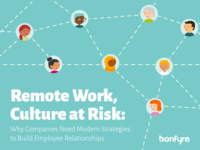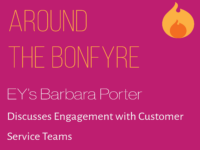Onboarding is a determining factor in how well employees will adapt to new roles. Digitals tools can help the process of onboarding new employees by providing knowledge, resources, and most importantly, connections to coworkers.
Onboarding is a make or break it point for new employees. SHRM reports that 69% of employees are more likely to stay with a company for at least three years if they have a good onboarding experience.
To ensure your onboarding process is working, it’s good to try and step into the shoes of a new employee. What are the main concerns a new hire faces? Usually, it’s understanding their role and getting acquainted with their coworkers and the overall company.
With these concerns in mind, we’ve outlined some ways to leverage digital tools while onboarding new employees to help them get to know their coworkers, build stronger relationships, understand their roles, and integrate into the company culture.
Make introductions easier when onboarding new employees
It can be daunting for new employees in large companies to get to know all their coworkers. Having a manager personally introduce them to every colleague and coworker usually isn’t feasible, especially when the workforce is partially remote or dispersed throughout different locations. Not to mention, after being introduced to so many new names and faces, it’s hard to remember who everyone is.
The good news is that technology has made introductions far less complicated. Using a digital tool, you can house an interactive company directory, organizing employees by department with their headshots, job title, and other details. This puts faces with names and helps new employees understand the organizational structure from the very first day. Similarly, employees can “meet” a new hire before they start. Managers might use a communication tool to share a photo of the new hire and a few fun facts about them, such as their background, where they’re from, and their favorite donut flavor. This will give their coworkers a quick glimpse of who the employee is, and will make in-person introductions a lot less stressful.
Encourage engagement with socialization opportunities
Building new relationships is vital to onboarding new employees. According to an estimate by SHRM, 60% of managers cite an inability to establish effective working relationships as the main reason for negative onboarding experiences. It’s easy to understand why–employees that feel connected to their coworkers are more likely to be happy and satisfied at work.
Encourage new hires to participate in digital communications tools. Consider setting up groups based on employees’ shared interests, such as interesting reads, photography, sports, or cooking. Inside these groups, employees can chat about pretty much anything related to the group topic.
You’re probably wondering what talking about a lasagna recipe or baseball has to do with onboarding. The answer lies in engagement and relationship-building. Think about the last time you were in a new situation. It’s a good assumption that once you found someone who shared a common interest, be it kids, a sport, or your latest TV show obsession, you immediately felt more connected to them and more comfortable. Having commonalities can increase engagement, and most importantly for new employees, they provide a means of getting to know coworkers beyond their job titles.
Related: Drive Emotional Engagement at Work With Technology
Show off your company culture while onboarding new employees
Digital tools are a great way to demonstrate your company culture when you’re onboarding new employees.
When your communication tools, for example, are both active and easy to access, it shows that you value transparency, two-way communication, and making sure employees are informed. Plus, being able to engage with coworkers and ask questions to fill their knowledge gaps will help new employees adapt to their new position faster.
Recognition tools are an excellent way to put company culture into something tangible and visible to new employees. Recognition provides new employees with an emotional connection to their new company, which is a great method of ensuring better retention and productivity further down the line. While a new employee may not accomplish a lot in the first period of their onboarding experience, you can still give them a shout out for their willingness to jump in and start learning. And even if the new employee isn’t the one being recognized, seeing that recognition does occur and comes both from leaders and peers drills down that your company acknowledges and appreciates the work that employees do.
Collect feedback to improve onboarding
When it comes to measuring and adjusting onboarding processes, survey tools are extremely useful. With a survey tool, you can gather feedback to gauge how employees feel about your onboarding process. Asking specific questions that dig into how employees feel will provide more actionable data to help you make adjustments to improve both their onboarding experience and key learning to apply for future employees.
Surveys can also help measure how well company culture is conveyed to new employees. During their first few months, you can send you surveys to see how well your company is doing. Do new hires feel engaged and connected with coworkers? Do they feel like they have the right information and tools to confidently do their jobs?
And when you actually act on that feedback, it shows that everyone in your company has a voice, no matter their rank in the organization or how long they’ve been there. Remember: every piece of feedback is valuable, but its usefulness is only comparative to how much you’re willing to invest in making changes.
We’ve given you a look at how digital tools–specifically ones that are centered around communication, recognition, and feedback–are helpful in making your onboarding process as successful and simple for new hires as possible. We encourage you to use this information to evaluate your current onboarding process and see how these digital tools can be used to enhance areas that you feel need improvement.



 3 min
3 min




